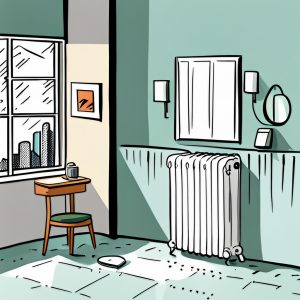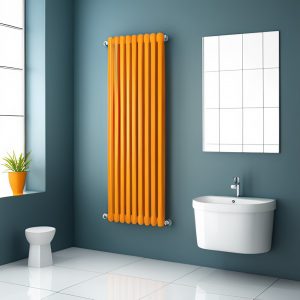Suppose you are a new homeowner or have recently purchased a property. In that case, knowing how to care for your radiators is essential. Many people are surprised by how simple it is to bleed a radiator and keep an efficient heating system throughout winter. In this blog post, Showers to You provide step-by-step instructions on exactly what needs to be done for their radiators to be efficiently working again. This straightforward guide will ensure you know the ins and outs of fixing cold spots during the chillier months.
What does bleeding a radiator mean?
Bleeding a radiator might sound daunting, but it’s pretty simple. It refers to the process of releasing any trapped air that has accumulated in the radiator over time. This air can prevent the hot water from circulating the radiator properly, resulting in cold spots and an inefficient heating system. Bleeding a radiator involves using a bleed key to open the valve at the top of the radiator and allowing air to escape, replacing it with hot water. This can improve the efficiency of your central heating system and keep you warm and toasty during the colder months.
Why do you need to bleed a radiator?
Over time, air bubbles can build up and get stuck, which causes the radiator to become less efficient at heating a room. Bleeding the radiator involves releasing that trapped air so the hot water can flow freely through the pipes. This easy maintenance task can make a huge difference in your home’s heating system, increasing energy efficiency and saving you money.

It is just as straightforward to bleed a Heated Towel Rail. The process is virtually the same as bleeding a Radiator!
Can you bleed a Heated Towel Rail?
Maintenance is critical to keeping them in good condition for heated towel rails. One common question is whether or not it’s possible to bleed them. The answer is yes. You can bleed a heated towel rail just like you would a radiator. Over time, air can become trapped in the system, preventing the rails from heating up properly. Bleeding the rails helps to remove any air pockets and ensures they’re running efficiently.
Simple Step-By-Step Guide:
Switch the heating on – To determine which radiator(s) needs bleeding, turn the heating on and let your home warm up thoroughly. Check each radiator or heated towel rail for cold spots and note which one(s) will need bleeding.
Switch the heating off – Turn the heating system off and let the radiators completely cool down. This is essential to ensure the hot water inside the radiator doesn’t cause accidental scalding when you start bleeding.
Find the Cold Spots – Locate the first radiator you wish to bleed and find the bleed valve. The valve will usually be located towards the top and side of the radiator.
Grab your towels or trays – Place a towel or bucket underneath the radiator and bleed valve. This catches any drips or leaks from dispersing on the floor.
Insert the Bleed Key – Insert the radiator bleed key into the valve until they have securely locked together.
Begin to turn – Make a slow anti-clockwise turn until you hear a hissing sound. This hissing sound is the trapped air escaping from the valve. Make sure you only open the valve partially or slowly to prevent any water from escaping.
Close the valve – Once the hissing noise has stopped and a small trickle of water starts to leak, you have successfully bled all of the trapped air inside the radiator.
Repeat – Follow these steps for all other home radiators or heated towel rails with cold spots.
Final Check – Turn your heating system back on and wait for the radiators to heat to their maximum. If there are still odd cold spots, try bleeding the radiator again.
How to Bleed a Radiator – Frequently Asked Questions
Q) Can you bleed a Radiator with the heating on?
A) The simple answer is no; it’s not recommended. Bleeding a radiator involves releasing the trapped air inside to improve its efficiency, and doing so while the heating is on can cause serious injury. Hot water and steam can escape, causing burns or scalds. Switch the heating off and wait for the radiators to cool down before attempting to bleed them. Check out our Bathroom Heating Guide for more detailed and in-depth information.
Q) When should you bleed a radiator?
A) As the colder months approach, we all want to ensure our homes are warm and comfortable. One way to do this is by providing your radiators work efficiently. If your radiators take longer than usual to heat up or not as well as they used to, it may be time to bleed them.

Autumn is generally considered the best time of year to bleed your radiators at home.
Q) What time of year is best to bleed a radiator?
A) Showers to You recommend checking all your radiators at least once a year to ensure your heating system works efficiently. The ideal time of year is around Autumn, just before the colder months settle in. Suppose there is an undiagnosed issue with any part of your heating system. In that case, it’s best practice to sort them before the system is required more than usual.
Q) Does bleeding a radiator reduce boiler pressure?
A) Bleeding a radiator involves letting out any trapped air to ensure it heats up properly. While this can have a negligible impact on the pressure in your system, it’s unlikely to make a significant difference. Bleeding your radiators regularly is still a good idea to keep your system running efficiently.
Q) Can you bleed a radiator too much?
A) It can bleed a radiator too much, negatively affecting your heating system. Too much bleeding can cause a drop in boiler pressure, leading to potential damage and costly repairs. It’s essential to bleed a radiator until only water comes out instead of air, but be cautious not to go overboard.
Why should I buy a Radiator/ Heated Towel Rail from Showers to You?
Our product range includes an array of Radiators and Heated Towel Rails, all competitively priced to ensure value for money. Our collection at Showers to You is expansive, catering to diverse tastes and requirements.
Whether you’re in the market for the sleek elegance of a Stainless Steel Radiator or the practicality and efficiency of an Electric Towel Rail, we have a product that will meet your needs and exceed your expectations. Our dedicated team can assist you via phone (01472 242159), email (info@showerstoyou.co.uk), or through our contact form.